| pA2 online © Copyright 2004 The British Pharmacological Society |
063P
University of Newcastle Winter Meeting December 2004 |
| Investigation of pharmacology of non-freezing cold injury in the rat tail vascular bed in vitro
J.P. Stephens, (D.W. Laight) & M.J. Tipton. IBBS, Division of Pharmacology, School of Pharmacy and Biomedical Sciences, University |
|
Non-freezing cold injury (NFCI) is a condition characterised by tissue damage after exposure to cold and/or wet conditions (Francis, 1984). The rat tail is a potential model of the condition since there is evidence it can develop some of the pathological changes seen both during and following NFCI in man (Thomas et al., 1994).
Male Wistar rats (250-300g) were killed by rising CO2 concentration. The lateral tail artery was exposed and cannulated prior to removal of the tail. Tails were perfused essentially as described by França et al. (1997) at a constant flow of 2.5ml min-1 with Krebs Ringer solution maintained at 37 ºC and pH 7.4. Increases in perfusion pressure (PP) in response to bolus doses of phenylephrine (PEP) (0.001-300nmol) were examined at room temperature and following 60-min, cold (5 °C ) water immersion.


Cold water immersion elevated vasoconstrictor responses to PEP (n=4) (Fig. 1), which were unchanged with time in room temperature control preparations (n=4) (Fig. 2). The NOS inhibitor L-NAME (0.3mM) elicited a significant leftward shift in vasoconstrictor reactivity to PEP ( ![]() pD2=1.08 ± 0.19, n=8, P<0.001) (Figs 3&4). Furthermore, in the presence of L-NAME, cold water immersion was associated with a significant rightward shift in vasoconstrictor reactivity to PEP (
pD2=1.08 ± 0.19, n=8, P<0.001) (Figs 3&4). Furthermore, in the presence of L-NAME, cold water immersion was associated with a significant rightward shift in vasoconstrictor reactivity to PEP ( ![]() pD2=0.82 ± 0.20, P<0.05) (Fig. 4).
pD2=0.82 ± 0.20, P<0.05) (Fig. 4).
In conclusion, cold water immersion acutely increased vasoconstrictor reactivity to an ![]() 1-adrenoceptor agonist. However, NOS inhibition unmasked a depressor effect of cold water immersion on vasoconstrictor reactivity, possibly due to a direct action on vascular smooth muscle. This may now suggest a complex effect of cold water immersion per se to damage endothelial function and vascular smooth muscle, resulting in a mild net increase in vasoconstrictor reactivity during NFCI.
1-adrenoceptor agonist. However, NOS inhibition unmasked a depressor effect of cold water immersion on vasoconstrictor reactivity, possibly due to a direct action on vascular smooth muscle. This may now suggest a complex effect of cold water immersion per se to damage endothelial function and vascular smooth muscle, resulting in a mild net increase in vasoconstrictor reactivity during NFCI.
Francis, T.J.R. (1984). J. R. Nav. Med. Serv. 70, 134-9.
Thomas, J.R. et al. (1994). Microvasc. Res. 3, 154-161.
França et al. (1997) Braz. J. Med. Biol. Res. 30, 891-5.